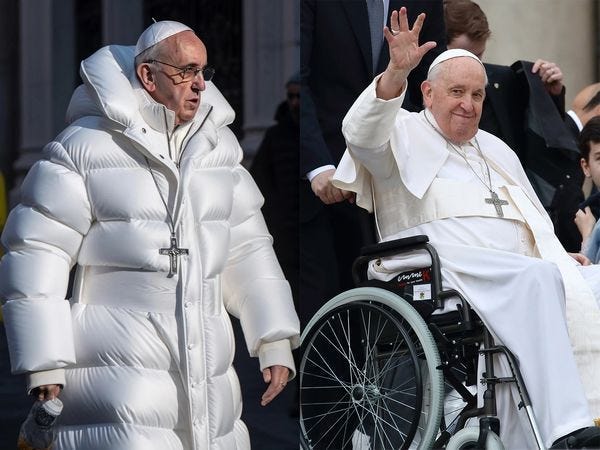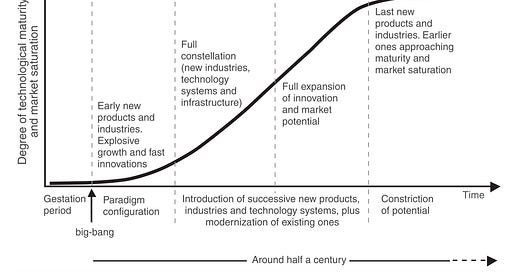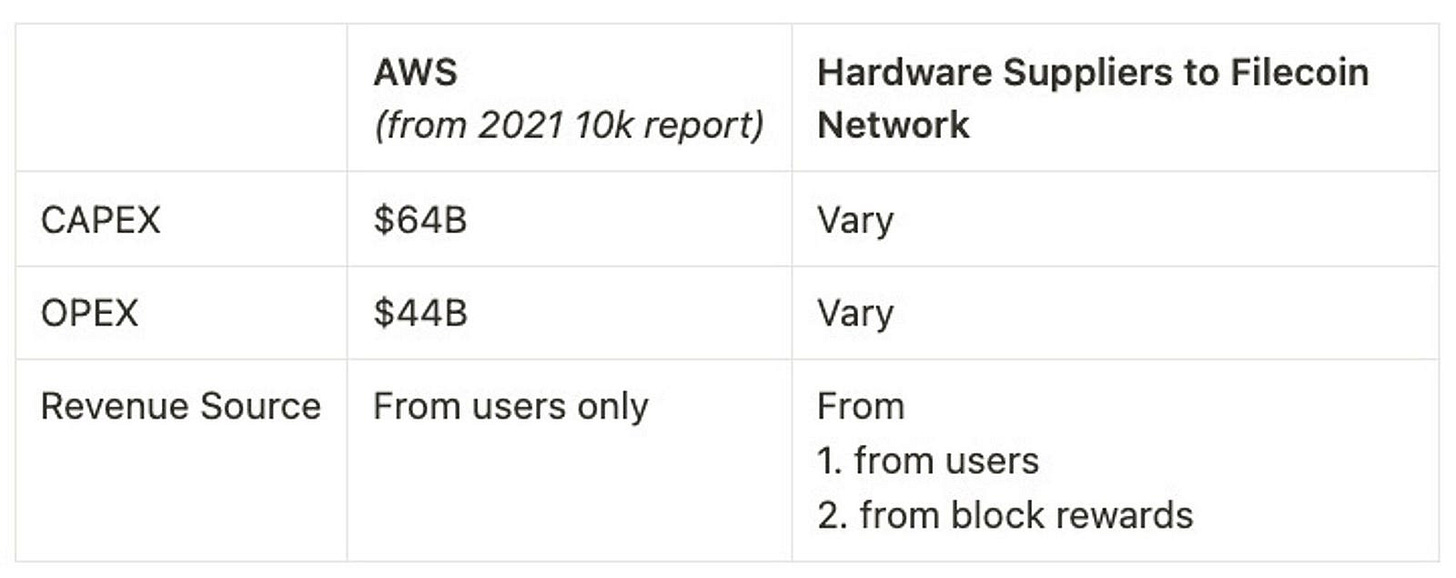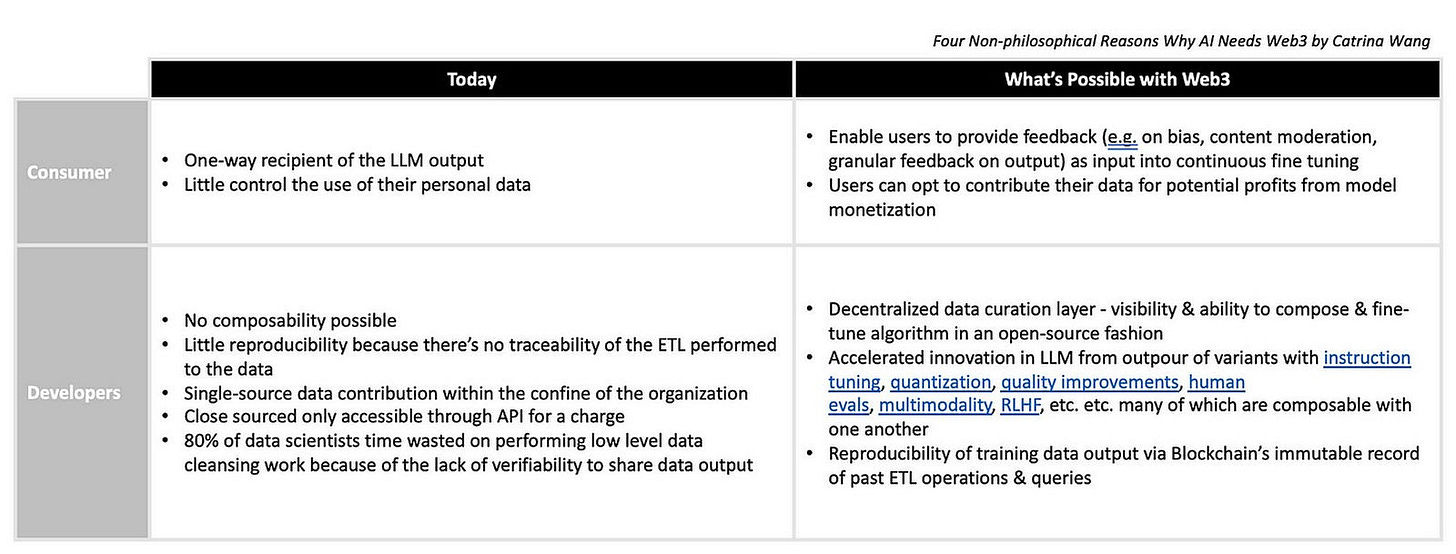Until recently, startups led the way in technological innovation due to their speed, agility, entrepreneurial culture, and freedom from organizational inertia. However, this is no longer the case in the rapidly growing era of AI. So far, big tech incumbents like Microsoft-owned OpenAI, Nvidia, Google, and even Meta have dominated breakthrough AI products.
What happened? Why are the “Goliaths” winning over the “Davids” this time around? Startups can write great code, but they are often too hindered to compete with big tech incumbents due to several challenges:
Compute costs remain prohibitively high
AI has a reverse salient problem: a lack of necessary guardrails that impede innovation due to fear and uncertainty around societal ramifications
AI is a black box
The data “moat” of scaled players (big tech) creates a barrier to entry for emerging competitors
So, what does this have to do with blockchain technology, and where does it intersect with AI? While not a silver bullet, DePIN (Decentralized Physical Infrastructure Networks) in Web3 unlocks new possibilities for solving the aforementioned challenges. In this blog post, I will explain how AI can be enhanced with the technologies behind DePIN across four dimensions:
Reduction of infrastructure costs
Verification of creatorship and humanity
Infusion of Democracy & Transparency in AI
Installation of incentives for data contribution
In the context of this article,
“web3” is defined as the next generation of the internet where blockchain technology is an integral part, along with other existing technologies
“blockchain” refers to the decentralized and distributed ledger technology
“crypto” refers to the use of tokens as a mechanism for incentivizing and decentralizing
1. Reduction of infra cost (compute and storage)
Every wave of technological innovation has been unleashed by something costly becoming cheap enough to waste
— Society’s Technical Debt and Software’s Gutenberg Moment by SK Ventures
The importance of infra affordability (in AI’s case, the hardware costs to compute, deliver, and store data) is highlighted by Carlota Perez’s Technological Revolution framework, which proposed that every technological breakthrough comes with two phases:
The Installation stage is characterized by heavy VC investments, infrastructure setup, and a “push” go-to-market (GTM) approach, as customers are unclear on the value proposition of the new technology.
The Deployment stage is characterized by a proliferation of infrastructure supply that lowers the barrier for new entrants and a “pull” GTM approach, implying a strong product-market fit from customers’ hunger for more yet-to-be-built products.
With definitive evidence of ChatGPT’s product-market fit and massive customer demand, one might think that AI has entered its deployment phase. However, there is still one piece missing still: an excess supply of infrastructure that makes it cheap enough for price-sensitive startups to build on and experiment with.
Problem
The current market dynamic in the physical infrastructure space is largely a vertically integrated oligopoly, with companies such as AWS, GCP, Azure, Nvidia, Cloudflare, and Akamai enjoying high margins. For example, AWS has an estimated 61% gross margin on commoditized computing hardware.
Compute costs are prohibitively high for new entrants in AI, especially in LLM.
ChatGPT costs an est. of 4M/training, and ~$700,000 per day to operate in hardware inference costs
Version two of Bloom will likely cost $10M to train & retrain
If ChatGPT were deployed into Google Search, it would result in $36B reduction in operating income for Google, a massive transfer of profitability from software platform (Google) to hardware provider (Nvidia)
Solution
DePIN networks such as Filecoin (the pioneer of DePIN since 2014 focused on amassing internet-scale hardware for decentralized data storage), Bacalhau, Render Network, and ExaBits (the coordination layers to match the demand for CPU/GPU with supply) can deliver 75% — 90%+ cost savings in infra costs via below three levers (Disclosure: author was an employee of Protocol Labs and advisor to ExaBits).
1. Pushing up the supply curve to create a more competitive marketplace
DePIN democratizes access for hardware suppliers to become service providers. It introduces competition to these incumbents by creating a marketplace for anyone to join the network as a “miner,” contributing their CPU/GPU or storage power in exchange for financial rewards.
While companies like AWS undoubtedly enjoy a 17-year head start in UI, operational excellence, and vertical integration, DePIN unlocks a new customer segment that was previously out-priced by centralized providers. Similar to how Ebay does not compete directly with Bloomingdale but rather introduces more affordable alternatives to meet similar demand, DePIN networks do not replace centralized providers but rather aim to serve a more price-sensitive segment of users.
2. Balancing the economy of these markets with cryptoeconomic design
DePIN creates a subsidizing mechanism to bootstrap hardware providers’ participation in the network, thus lowering the costs to end users. To understand how, let’s first compare the costs & revenue of storage providers in web2 vs. web3 using AWS and Filecoin.
Lower fees for clients: DePIN networks create competitive marketplaces that introduce Bertrand-style competition resulting in lower fees for clients. In contrast, AWS EC2 needs a mid-50% margin and 31% overall margin to sustain operations;
Token incentives/block rewards are emitted from DePIN networks as a new revenue source. In the context of Filecoin, hosting more real data translates to earning more block rewards (tokens) for storage providers. Consequently, storage providers are motivated to attract more clients and win more deals to maximize revenue. The token structures of several emerging compute DePIN networks are still under wraps, but will likely follow a similar pattern. Examples of such networks include:
3. Reducing overhead costs: benefits of DePIN networks like Bacalhau and ExaBITS, and IPFS/content-addressed storage include
Creating usability from latent data: there is a significant amount of untapped data due to the high bandwidth costs of transferring large datasets. For instance, sports stadiums generate vast amounts of event data that is currently unused. DePIN projects unlock the usability of such latent data by processing data on-site and only transmitting meaningful output.
Reducing OPEX costs such as data input, transport, and import/export by ingesting data locally.
Minimizing manual processes to share sensitive data: for example, if hospitals A and B need to combine respective sensitive patient data for analysis, they can use Bacalhau to coordinate GPU power to directly process sensitive data on-premise instead of going through the cumbersome administrative process to handle PII (Personal Identifiable Information) exchange with counterparties.
Removing the need to recompute foundational datasets: IPFS/content-addressed storage has built-in properties that deduplicate, trace lineage, and verify data. Here’s a further read on the functional and cost efficiencies brought about by IPFS.
Summary by AI: AI needs DePIN for affordable infrastructure, which is currently dominated by vertically integrated oligopolies. DePIN networks like Filecoin, Bacalhau, Render Network, and ExaBits can deliver cost savings of 75%-90%+ by democratizing access to hardware suppliers and introducing competition, balancing the economy of markets with cryptoeconomic design, and reducing overhead costs.
2. Verification of Creatorship & Humanity
Problem
According to a recent poll, 50% of A.I. scientists agree that there is at least a 10% chance of A.I. leading to the destruction of the human race.
This is a sobering thought. A.I. has already caused societal chaos for which we currently lack regulatory or technological guardrails — the so-called “reverse salient.”
To get a taste of what this means, check out this Twitter clip featuring podcaster Joe Rogan debating the movie Ratatouille with conservative commentator Ben Shapiro in an AI-generated video.

Unfortunately, the societal ramifications of A.I. go much deeper than just fake podcast debates & images:
The 2024 presidential election cycle will be among the first where a deepfake AI-generated political campaign becomes indistinguishable from the real one
An altered video of Senator Elizabeth Warren made it appear like Warren was saying Republicans should not be allowed to vote (debunked)
The voice clone of Biden criticizing transgender women
A group of artists filed a class-action lawsuit against Midjourney and Stability AI for unauthorized use of artists’ work to train AI imagery that infringed on those artists’ trademarks & threatened their livelihood
A deepfake AI-generated soundtrack, “Heart on My Sleeve” featuring The Weeknd and Drake, went viral before being taken down by the streaming service. Such controversy around copyright violation is a harbinger of the complications that can arise when a new technology enters the mainstream consciousness before the necessary rules are in place. In other words, it is a Reverse Salient problem.
What if we can do better in web3 by putting some guardrails on AI?
Solution
Proof of Humanity and Creatorship with cryptographic proof of origination on-chain
This is where we can actually use Blockchain for its technology — as a distributed ledger of immutable records that contain tamper-proof history on-chain. This makes it possible to verify the authenticity of digital content by checking its cryptographic proof.
Proof of Creatorship & Humanity with Digital Signature
To prevent deep fakes, cryptographic proof can be generated using a digital signature that is unique to the original creator of the content. This signature can be created using a private key, which is only known to the creator, and can be verified using a public key that is available to everyone. By attaching this signature to the content, it becomes possible to prove that the content was created by the original creator — whether they are human or AI — and authorized/unauthorized changes to this content.
Proof of Authenticity with IPFS & Merkle Tree
IPFS is a decentralized protocol that uses content addressing and Merkle trees to reference large datasets. To prove changes to a file’s content, a Merkle proof is generated, which is a list of hashes that shows a specific data chunk is in the Merkle tree. With every change, a new hash is generated and updated in the Merkle tree, providing proof of file modification.
A pushback against such a cryptographic solution may be incentive alignment: after all, catching a deep fake generator doesn’t generate as much financial gain as it reduces the negative societal externality. The responsibility will likely fall on major media distribution platforms like Twitter, Meta, Google, etc. to flag, which they are already doing.
So why do we need Blockchain for this?
The answer is that these cryptographic signatures and proof of authenticity are much more effective, verifiable, and deterministic. Today, the process to detect deep fakes is largely through machine learning algorithms (such as the “Deepfake Detection Challenge” of Meta, “Asymmetric Numeral Systems” (ANS) of Google, and c2pa) to recognize patterns and anomalies in visual content, which is not only inaccurate at times but also falling behind the increasingly sophisticated deep fakes. Often, human reviewer intervention is required to assess authenticity, which is not only inefficient but also costly.
Imagine a world where each piece of content has its cryptographic signature so that everyone will be able to verifiably prove the origin of creation and flag manipulation or falsification — a brave new one.
Summary by AI: AI poses a significant threat to society, with deep fakes and unauthorized use of content being major concerns. Web3 technologies, such as Proof of Creatorship with Digital Signature and Proof of Authenticity with IPFS and Merkle Tree, can provide guardrails for AI by verifying the authenticity of digital content and preventing unauthorized changes.
3. Infusion of Democracy in AI
Problem
Today, AI is a black box comprised of proprietary data + proprietary algorithms. Such closed-door nature of Big Tech’s LLM precludes the possibility of what I call an “AI Democracy,” where every developer or even user should be able to contribute both algorithms and data to an LLM model, and in term receive a fraction of the future profits from the model (as discussed here).
AI Democracy = visibility (the ability to see the data & algorithm input into the model) + contribution (the ability to contribute data or algorithm to the model).
Solution
AI Democracy aims to make generative AI models accessible for, relevant to, and owned by everyone. Below table is a comparison illustrating what is possible today vs. What will be possible, enabled by blockchain technology in Web3.
Today:
For consumers:
One-way recipient of the LLM output
Little control over the use of their personal data
For developers:
Little composability possible
Little reproducibility because there’s no traceability of the ETL performed on the data
Single-source data contribution within the confine of the owner organization
Close sourced only accessible through API for a charge
80% of data scientists’ time is wasted on performing low-level data cleansing work because of the lack of verifiability to share data output
What blockchain will enable
For consumers:
Users can provide feedback (e.g. on bias, content moderation, granular feedback on output) as input into continuous fine-tuning
Users can opt to contribute their data for potential profits from model monetization
For developers:
Decentralized data curation layer: crowdsource tedious & time-consuming data preparation processes such as data labeling
Visibility & ability to compose & fine-tune algorithms with verifiable & built-on lineage (meaning they can see a tamper-proof history of all changes in the past)
Sovereignty of both data (enabled by content-addressing/IPFS) and algorithm (e.g. Urbit enables peer-to-peer composability and portability of data & algorithm)
Accelerated innovation in LLM from the outpour of variants from the base open-source models
Reproducibility of training data output via Blockchain’s immutable record of past ETL operations & queries (e.g. Kamu)
One might argue that there’s a middle ground of Web2 open source platforms, but it’s still far from optimal for reasons discussed in this blogpost by exaBITS.
Summary by AI: The closed-door nature of Big Tech’s LLM precludes the possibility of an “AI Democracy,” where every developer or user should be able to contribute both algorithms and data to an LLM model, and in turn receive a fraction of the future profits from the model. AI should be accessible for, relevant to, and owned by everyone. Blockchain networks will enable users to provide feedback, contribute data for potential profits from model monetization, and enable developers to have visibility and the ability to compose and fine-tune algorithms with verifiability and built-on lineage. Sovereignty of both data and algorithm will be enabled by web3 innovations such as content-addressing/IPFS and Urbit. Reproducibility of training data output via Blockchain’s immutable record of past ETL operations and queries will also be possible.
4. Installation of Incentives for Data Contribution
Problem
Today, the most valuable consumer data is proprietary to big tech platforms as an integral business moat. The tech giants have little incentive to ever share that data with outside parties.
What about getting such data directly from data originators/users? Why can’t we make data a public good by contributing our data and open-source it for talented data scientists to use?
Simply put, there’s no incentive or coordination mechanism for that. The tasks of maintaining data and performing ETL (extract, transform & load) incur significant overhead costs. In fact, data storage alone will become a $777 billion industry by 2030, not even counting computing costs. Why would someone take on the data plumbing work and costs for nothing in return?
Case in point, OpenAI started off as open-source and non-profit but struggled with monetization to cover its costs. Eventually, in 2019, it had to take the capital injection from Microsoft and close off its algorithm from the public. In 2024, OpenAI is expected to generate $1 billion in revenue.
Solution
Web3 introduces a new mechanism called dataDAO that facilitates the redistribution of revenue from the AI model owners to data contributors, creating an incentive layer for crowd-sourced data contribution. Due to length constraints, I won’t elaborate further, but below are two related pieces.
How DataDAO works by HQ Han of Protocol Labs
How data contribution and monetization works in web3, where I dove into the mechanics, missing pieces, and emerging inevitable opportunities in dataDAOs
In conclusion, DePIN is an exciting new category that offers an alternative fuel in hardware to power today’s renaissance of innovations in web3 and AI. Although big tech companies have dominated the AI industry, there is potential for emerging players to compete by leveraging blockchain technologies: DePIN networks lower the barrier to entry in compute costs; blockchain’s verifiable & decentralized properties make true open IA possible; innovative mechanisms, such as dataDAOs, incentivize data contribution; and the immutable and tamper-proof property of Blockchain provides proof of creatorship to address concerns regarding the negative societal impact of AI.
Appendix
Shoutout to below SMEs and friends for providing input and/or reviewing my draft: Jonathan Victor & HQ Han of Protocol Labs, Zackary B of exaBITS, Professor Daniel Rock of Wharton, Evan Fisher of Portal Ventures, David Aronchick of Bacalhau, Josh Lehman of Urbit, and more
About Author
Partner at Portal Ventures | @CuriousCatWang on Twitter








Fascinating article. Thanks for sharing
Hi thanks for the amazing article! I'm currently doing research on this topic and would love to hear your thoughts regarding the necessity of using blockchain technology in the verifying authenticity of digital content in particular.
Here's how I conceptualise the current user journey:
1. Person A takes picture of a scenery with his phone, uses his private key to create a cryptographic hash of the image. Anyone using their public key can check against the hash to verify that this image indeed originated from person A.
2. The cryptographic hash of the image can be stored on a blockchain. Blockchain is immutable, meaning that any additional attempts by malicious actors to alter the cryptographic hash will fail because it'll be easily spotted and the network will not reach consensus on this particular version of the truth. It is also transparent, and further edits on the photo made by other individuals using softwares like Adobe Lightroom will be noted in the subsequent blocks, thus creating a transparent and auditable track record of edits done on the photo.
3. When Person B sees the image on the web, he can check immediately the origin of the photo and all the edits that have been made.
My immediate thoughts on this are as such:
1. Deepfake Verification: The blockchain doesn't inherently have a way to discern whether an image is a deepfake or not. Its primary function in this context is to maintain an immutable and verifiable record of ownership and modification. The detection and prevention of deepfakes would require sophisticated AI and machine learning techniques, separate from the blockchain itself. In the user journey above, if Person A creates an ultra-realistic deepfake and signs it with his private key, it can still be propagated as authentic content from Person A. Perhaps what blockchain & cryptography enables is a sort of reputation slashing mechanism to keep deepfakes in check.
2. Hardware & Software standards: To have a completely transparent and tamper-evident system, all hardware and software used in the creation and modification of content would need to follow the same standards and protocols for cryptographic signing and proof generation. This would require significant coordination and cooperation across industries. In the example above, this would mean having the metadata of the phone camera used to take the photo and that of the photo-editing softwares used being included when generating the hash. However, this also means that power will likely concentrate in the hands of the coalition setting the industry standards, and smaller hardware and software players will have to opt in as a matter of survival. The sharing of hardware and software metadata may also raise privacy issues. In the example above, maybe the metadata of the phone camera used to take the photo can be included in the hash so that Person B can verify that it's indeed not generated by AI.
3. Digital Identity Solution: A registry linking a person's digital identity to their real identity and owned devices is a prerequisite for the system to function as intended. It's a challenging problem and a sensitive one due to privacy and security concerns. This is also the part that I’m the most confused by.
Cryptographic proof provides the “fingerprint” for the digital content, and blockchain technology seems to be a fingerprint storage solution that ensures its access in an immutable and accessible solution.
Specifically, it can be used in 2 ways:
1. It enables a decentalised, immutable registry of provenance data (check if the content has been altered), &
2. It serves as the foundation on top of which a decentralised registy mapping digital identity to real-world identity is built (check who’s the one that altered it)
This is where I’m confused. C2PA’s setting the hardware and software standard for image authentication and it doesn’t concern itself with linking user’s digital identity to their real-world identity. It also doesn't use blockchain at all in achieving this. Blockchain can be used in this regard but I don’t see any viable solutions out there yet. Will person B be able to verify that 1) person A (identity revealed) is the original creator of the image, 2) a pseudonym of person A is, or 3) a “trusted and verified” individual is the creator? Seems to me that this depends on the design of the identity system but I’m finding it hard to conceptualise how it might fit in with the standards out there like C2PA. Also is a blockchain really necessary if we can trust the centralised cloud storage provider that’s storing the cryptographic hash? I assume that the value-add of blockchain here's not solely limited to decentralisation?
Still trying to wrap my head around this topic, happy to hear your thoughts! Really appreciate it :)